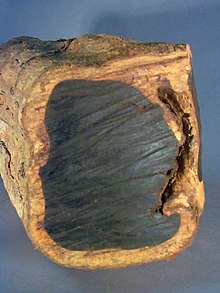Ebony (tree)
Ebony is a dense darker than brown hardwood, coming from some species in the genus Diospyros, which has persimmons as well. Not like most trees, ebony is dense enough to slowly fall in water. It is softly textured and has a mirror finish when polished, making it great as an ornamental wood.[1] The word ebony comes from the Ancient Egyptian hbny, through the Ancient Greek ἔβενος (ébenos), as well as Latin and Middle English.[2]

Species
changeThe ebony tree has many species (types), having Diospyros ebenum (Ceylon ebony), that lives in southern India and Sri Lanka; D. crassiflora (Gabon ebony), usually in western Africa; D. humilis (Queensland ebony), native to Queensland, the Northern Territory, New Guinea and Timor; and D. celebica (Sulawesi ebony), native to Indonesia and prized for its nice, multi-colored wood grain. Mauritius ebony, D. tessellaria, was largely overused by the Dutch in the 17th century. Some species in the genus have an ebony with similar looks, but striped rather than the even black of D. ebenum.
Uses
changeEbony has been used for a very long time, and carved pieces have been found in Ancient Egyptian tombs.[3]
By the end of the 16th century, fine cabinets for the luxury trade were made of ebony in Antwerp. The wood's dense hardness helped people create refined moldings framing finely detailed pictorial panels with carving in very low relief (bas-relief), usually of allegorical subjects, or with scenes taken from classical or Christian history. Within a short time, such cabinets were also being made in Paris, where their makers became known as ébénistes, which remains the French term for a cabinetmaker.
Modern uses are largely restricted to small items, such as crucifixes, the main body of some musical instruments such as the clarinet, oboe, or piccolo and musical instrument parts, including black piano, organ, and harpsichord keys; violin, viola, mandolin, guitar, double bass, and cello fingerboards; tailpieces; tuning pegs; chinrests; and bow frogs. Many plectrums, or guitar picks, are made from ebony.
Traditionally, black chess pieces were made from ebony, with boxwood or ivory being used for the white pieces. Modern East Midlands-style lace-making bobbins, also being small, are often made of ebony and look particularly decorative when bound with brass or silver wire. Some expensive handgun grips and rifle fore-end tips are still made of ebony, as are the butts of pool cues.
As a result of unsustainable harvesting, many species yielding ebony are now considered threatened. Most indigenous ebony in Africa in particular has been cut down illegally.
Protection
changeIn Sri Lanka, ebony is a protected species and harvesting and sale of ebony is illegal and punishable by imprisonment.
In 2011, the Gibson Guitar company was raided by the US Fish and Wildlife Service for violations of the Lacey Act of 1900, which prohibits the illegal importation of threatened woods and other materials.[4]
An ebony and rosewood expert at the Missouri Botanical Garden calls the Madagascar wood trade the "equivalent of Africa's blood diamonds".[5]
Gallery
change-
Japanese clothes brush
-
Kamagong (ebony) chair
-
Planks of wood including Gabon ebony
-
Violin fingerboard and tuning pegs
-
A Gibson Les Paul guitar with an ebony fretboard
References
change- ↑ "Gaboon Ebony". www.wood-database.com/ Lumber Identification (Hardwoods). The Wood Database. Retrieved 2016-12-11.
- ↑ Beekes, R. S. P.; van Beek, Lucien (2009). Etymological Dictionary of Greek. Leiden: Brill. p. 368. ISBN 978-90-04-17418-4.
- ↑ D.M., Dixon (19 February 1961). The ebony trade of ancient Egypt. discovery.ucl.ac.uk (Doctoral).
- ↑ Fanelli, Damian (2012-08-07). "Gibson Agrees to Pay $350,000 in Penalties, Loses Seized Imported Ebony". guitarworld. Retrieved 2023-01-07.
- ↑ Felten, Eric (August 26, 2011). "Guitar Frets: Environmental Enforcement Leaves Musicians in Fear". Wall Street Journal. Archived from the original on October 6, 2015.